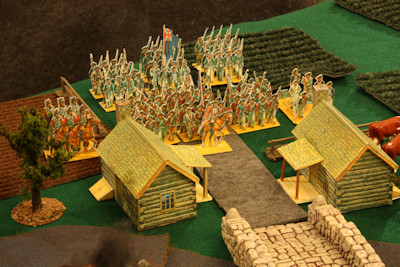Before illustrating the battle, here is a quick peak at how the soldiers are made. First you copy or scan pages from a Peter Dennis book, or you download files from his web site. Then print off a page such as the American Militia page shown at right. Fold over and glue the soldiers to have matching fronts and backs. Cut out as much of the back ground as possible. Glue the soldiers to a cardboard stand. You now have a small, inexpensive stand of paper miniatures. Peter provides several pages and YouTube videos to show you the process.
Repeat the process until you have as many regiments and brigades as you need for your battle.
Also in the Peter Dennis book are pages for houses and scenery that you can use for battles. The rest of this article has nice paper houses from Peter Dennis. Other scenery elements (fields, felt roads and rivers, and hills) come from items I had from my other miniatures games.
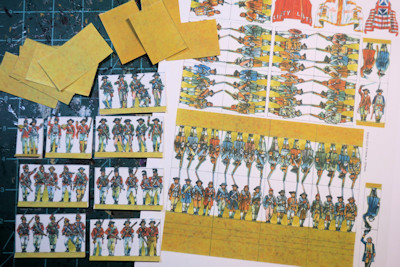
In this photo we see a map of the Battle of Springfield (1780) in New Jersey from Thomas J. Fleming's book The Forgotten Victory: The Battle for New Jersey 1780. The British invaded New Jersey from Staten Island and occupied Elizabethtown. The British headed west on Galloping Hill Road, now known as Morris Avenur or State Route 82. As they marched, they burned parts of Elizabethtown and Connecticut Farms (which is now called Union) including the original wooden Connecticut Farms Church They also killed Parson Caldwell's wife Hannah Caldwell. Parson Caldwell headed west and led some of the militia in the following battle.
As the British approached, the Americans lit beacon fires and fired warning cannons from the Watchung and Newark Mountains to call the militia to arms. George Washington was farther west in Morristown, but the road was guarded by the American cannons on the hills.
To take Springfield, the British divided their superior forces into two. The northern flank led by General Mathew passed through the village of Vauxhall. The southern flank led by General Knyphausen came over a rise known now as Battle Hill. Both flanks had to cross the Rahway River, and this is where the Americans made their stand. American commander Greene defended Springfield via several regiments led by Colonel Dayton, General Heard, Colonels Angell, Shreeve, and Dickinson and the 2nd New Jersey Regiment. Vauxhaul was defended by Major Lee and Colonel Ogden and the 1st New Jersey Regiment.
The American militia and skirmishing riflemen fought fiercely for the bridges while the American regular regiments were held in reserve. The British with their Loyalist American allies and hired German mercenaries (Hessians) pounded the Americans with their superior fire power. Read on to see what happens next.
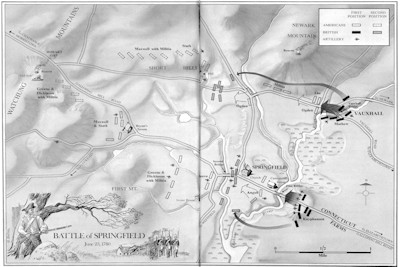
In this photo we see an overview of the Battle of Springfield 1780. The bluish-brown north-south felt lines represent the various tributaries of the Rahway River. On the top right we see the farms of the village of Vauxhall and the Vauxhall Road river crossing. American cannons and a beacon fire are shown on Newark Mountain at top center.
On the bottom right, we see the burning farms and houses of Connecticut Farms. The British forces are gathering on Battle Hill to assault the forces at the Galloping Hill Road crossing of the Rahway River. The town of Springfield with amassing American militia and regular infantry are shown by the church and houses at middle left.
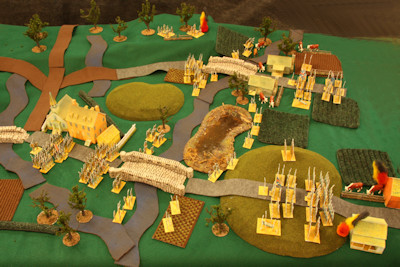
In this photo we see a British southern flank view looking west at the Battle of Springfield. Connecticut Farms is burning in the foreground. British and Hessian hunters and Native American allies are on the eastern banks of the river and the swampy grounds. On the hill the British infantry, Hessians, canons, and dragoon horsemen gather. The American riflemen and militia are on the western side of the river. In the background, we see the town of Springfield and the American gathering point of Bryant's Tavern at the distant crossroads.
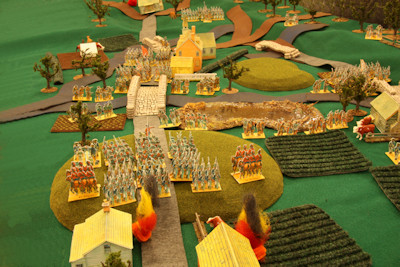
In this photo we see closer view from the British soutern flank looking west. General Knyphausen leads the British redcoats (musket infantry) and Hessian grenadiers (Germany mercenary infantry) from Battle Hill. The British cannons fire down on the American defenders of the bridge.
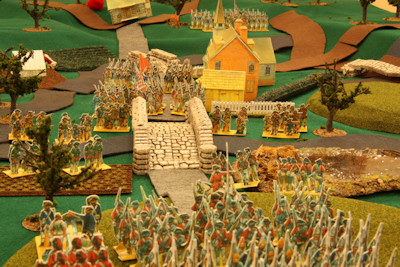
In this photo we see the American southern flank view looking east toward the Rahway River and Connecticut Farms. American regular infantry, militia, and skirmishing riflemen are trying to hold the bridge and prevent the British from taking Springfield. American general Greene, and subordinates Maxwell, Starke, and Dickinson, along with Parson Caldwell are giving the British all they've got. Casualties are heavy on both sides.
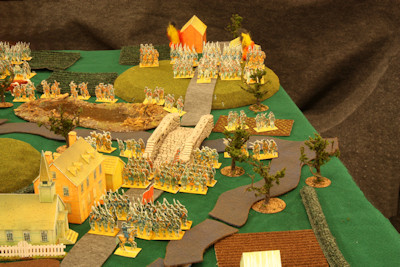
In this photo we see a close up of the American southern flank view looking east. In the background Connecticut Farms is burning. The Springfield house at left is hit by a cannon ball. To this day it is a museum of the war known as "the Cannonball House".
As Americans run out of fiber wadding for their muskets, Parson Caldwell enters the Springfield church, gathers up all the copies of Watts' hymn books, and distributes them to the American soldiers to use the pages as musket wadding. Parson Caldwell yells, "Give 'em Watts boys!"
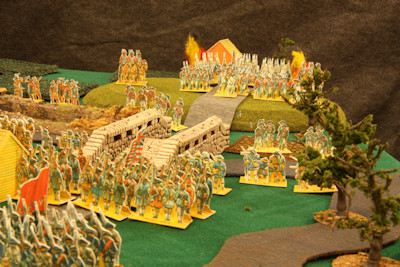
In this photo we see the British view of the northern flank of the Battle of Springfield 1780. This is the village of Vauxhall with the main road Vauxhall Road crossing of the Rahway River. British red coats, Loyalist Americans, dragoon horsemen, and Native Americans advance to take the river crossing. From the hills of Newark Mountain, American cannons fire on the British.
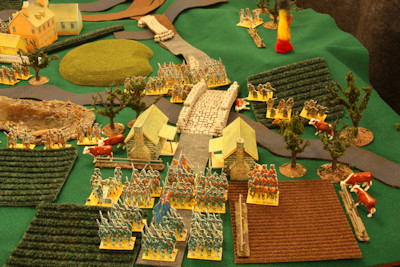
Here is a close up of the British northern flank in Vauxhall led by General Mathews. Eventually these British make it to the Short Hills to face more Americans lead by American General Ogden.
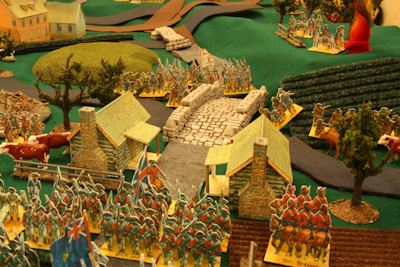
In this photo we see the American northern flank view looking east at the Battle of Springfield. The Americans are outgunned and eventually have to retreat from the bridge. Britsh scramble up the side up the elevated position atop Newark Mountain and force the Americans to retreat as well.
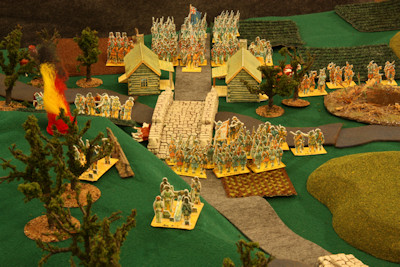
And now for the aftermath. Both sides suffered heavy casualties. British General Knyphausen did take the Rahway River bridge and occupy the town of Springfield. British General Mathew occupied Vauxhall and cleared the militia from overlooking Newark Mountain. He reached the Short Hills and encamped. The British never did reach Bryant's Tavern or the Hobart Gap which lead to Morristown.
General George Washington gave direction to the American leaders Greene, Maxwell, Stark, and Dickinson. With a very good defense, the outgunned Americans gave the British second thoughts about the invasion of New Jersey. Within days, the British marched back to Elizabethtown and returned to the safer grounds on Staten Island. Following this battle, there were few major engagements in New Jersey. George Washington maintained his stronghold and was able to launch successful campaigns in other states. He said about the New Jersey militia, "They flew to arms universally and acted with a spirit equal to anything I have seen in the course of the war".
